IX - The Chest Wall
Editors: Shields, Thomas W.; LoCicero, Joseph; Ponn, Ronald B.; Rusch, Valerie W.
Title: General Thoracic Surgery, 6th Edition
Copyright 2005 Lippincott Williams & Wilkins
> Table of Contents > Volume I - The Lung, Pleura, Diaphragm, and Chest Wall > Section X - The Diaphragm > Chapter 50 - Pacing of the Diaphragm
Chapter 50
Pacing of the Diaphragm
John A. Elefteriades
Jacquelyn A. Quin
The concept of using electricity to stimulate artificial respiration, noted by Beard and Rockwell in 1875, dates back to a suggestion by Cavallo of using electrical stimulation of the phrenic nerve as a technique for cardiopulmonary resuscitation in his 1777 treatise on the uses of electricity for human ailments. Several years later, Hufeland (1783), in his doctoral dissertation entitled The Use of Electricity in Asphyxia, recommended stimulation of the phrenic nerve to induce contraction of the diaphragm. In 1818, Ure (1819) demonstrated the feasibility of electrical stimulation of the phrenic nerve in a freshly hung criminal. The success of it was truly wonderful. Full breathing instantly commenced. The chest heaved and fell; the belly was protruded and again collapsed, with the relaxing and retiring diaphragm (Fig. 50-1). Electrical stimulation of the phrenic nerve was popularized subsequently by Duchenne de Boulogne during a cholera epidemic in 1849 as a technique for cardiopulmonary resuscitation for the treatment for asphyxia, as noted by Erdmann in 1858. In a subsequent monograph on the use of phrenic nerve stimulation, Duchenne (1872) reported, it is apparent from all my experiments on men and on animals, alive and dead, that stimulation of the phrenic nerve by electrical current can produce contraction of the diaphragm. In 1927, Israel reported on the use of transcutaneous stimulation of the phrenic nerves for ventilation of six apneic newborns, all of whom survived. In the 1950s, Sarnoff and associates (1950) used electrophrenic respiration extensively to treat victims of the polio epidemic.
Long-term, continuous pacing of the conditioned diaphragm as it exists today became possible through the efforts of Glenn and associates (1964, 1972, 1976, 1984, 1986). Applying their experience with radiofrequency cardiac pacemakers, they reported first on continuous radiofrequency stimulation of the phrenic nerve for several days in an animal model in 1964, and first applied to a patient with chronic ventilatory insufficiency in 1966, as reported by Judson and Glenn (1968). Complete ventilatory support of a quadriplegic patient was achieved in 1972. In 1980, continuous bilateral, low-frequency stimulation of the conditioned diaphragm for complete respiratory support was advocated by Glenn (1980) and colleagues (1984), who recognized that bilateral high-frequency ventilation induced excessive fatigue.
A number of organized programs for diaphragm pacing have been established in the United States and abroad. Presently, more than 1,000 pacemakers have been implanted; most patients derive benefit from placement of the pacemaker.
Advances and improvements in electrophrenic respiration continue as experimental developments in pacing technique are applied to clinical practice. One such example is intercostal muscle recruitment, in which ventilation is conducted by stimulation of the upper thoracic nerve roots using spinal cord epidural electrodes, as reported in the studies of DiMarco and associates (1987, 1989, 1994). Intercostal muscle recruitment has been shown to maintain ventilation independently for brief periods of time; when it is used in combination with phrenic nerve stimulation, Supinski (1991) reported that a synergistic effect on ventilation may be seen.
INDICATIONS
Pacing of the diaphragm has become an established mode of ventilatory support in two clinical settings: central alveolar hypoventilation and high cervical spinal cord injury. These two indications account for most clinical cases of diaphragm pacing.
The use of diaphragm pacing has been studied in two additional conditions: intractable hiccups and end-stage chronic obstructive pulmonary disease. Diaphragm pacing was found by Glenn and one of us (JAE) (1991) to be effective in treating patients with intractable hiccups; however, the numbers of patients with truly intractable hiccups who require such surgical control are few. As previously suggested by Glenn and colleagues (1978), diaphragm pacing also has been used in patients with end-stage chronic obstructive
P.747
pulmonary disease in whom ventilatory drive is based on hypoxia rather than hypercarbia. The administration of as little as 24% oxygen may cause episodic respiratory failure in these patients because the hypoxic drive becomes increasingly diminished. Diaphragm pacing can provide oxygen-protected ventilation (continued adequacy of ventilation despite loss of hypoxic drive). As with hiccups, the number of patients with such severe progression of chronic obstructive pulmonary disease is limited.
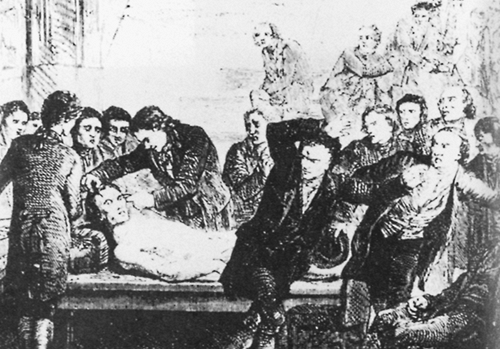 |
Fig. 50-1. Ure's induction of artificial respiration (Glasgow, 1818) by galvanic stimulation of the left phrenic nerve in a freshly hung criminal. From Ure A: An account of some experiments made on the body of a criminal immediately after execution, with physiological and practical observations. J Sci Arts (Lond) 6:283, 1819. With permission. |
Central Alveolar Hypoventilation
The various sleep apnea syndromes and terminology should be distinguished because treatment modalities differ. Shneerson (1988) has provided a comprehensive review. The most basic distinction is between obstructive and central sleep apnea. In obstructive sleep apnea, upper airway obstruction during inspiration prevents adequate ventilation; however, the respiratory drive is normal, and respiratory muscle activity is preserved. The dilemma for these patients is anatomic: the brain tells the muscles to breathe, but closure of the upper airway prevents exchange of air. Causes of obstructive apnea include pharyngeal tumors, dysmorphology of the pharynx, obesity, and exaggerated relaxation of the pharyngeal musculature during sleep. Obstructive sleep is not treated with phrenic nerve pacing but rather through correction of the underlying mechanical obstruction. Intermittent positive-pressure breathing, or nasal bilevel positive airway pressure, may be used to support ventilation in these circumstances. The positive pressure overcomes the mechanical airway obstruction. Theapparatus usually is applied at night when needed and removed during the day.
Distinct from obstructive sleep apnea is central sleep apnea (central hypoventilation), in which a failure of the respiratory drive itself exists. The brain fails to control the process of ventilation. This disease process stems from malfunction of the respiratory control center of the medulla. This may occur when the medulla becomes involved in a number of disease processes, including infection (e.g., encephalitis), stroke, or trauma including iatrogenic injury. Some cases, which are thought to be idiopathic, probably represent dysfunction of the medullary chemoreceptors that normally detect hypoxia and hypercarbia.
In recent years, the syndrome of congenital central hypoventilation syndrome has become increasingly recognized and clarified, as reported by Hunt and Silvestri (1997) and by Sritippayawan and associates (2002). A genetic predisposition has come to light. Recognition of this syndrome and treatment by diaphragm pacing have led to encouraging clinical results.
It is increasingly recognized that the blunted nocturnal response to hypoxia and hypercapnia that characterizes central sleep apnea also prevails during the day in many, if not most, afflicted patients; however, ventilation may be augmented to a certain extent in the awake individual by conscious effort. For this reason, central alveolar hypoventilation is a preferred descriptor over sleep apnea. The term Ondine's curse also has been used extensively in the literature to describe this condition. The term originates from the Latin word unda, or wave. Undines were water spirits. In 1811 and translated into English in 1839, German baron Friedrich Heinrich Karl de la Motte Fouque published Undine, the fictional story of a water nymph who placed a curse on her mortal husband for unfaithfulness. From original works evolved Ondine, from French playwright Giraudoux (1946),
P.748
that told the story of a mortal who was cursed to stop breathing whenever he fell asleep for having married a water nymph.
 |
Fig. 50-2. The ventilatory response to hypercapnia and hypoxia. A. Normal individuals. B. Patients with chest wall disorders. C. Patients with central hypoventilation. |
Patients with central alveolar hypoventilation often have a pickwickian habitus. Chronic hypoxia and hypercapnia, as well as the fragmented sleep pattern, lead to daytime somnolence. Over time, pulmonary vasoconstriction, secondary to chronic hypoxia, may lead to fixed pulmonary hypertension, which may ultimately result in right-sided heart failure.
The adequacy of the respiratory drive is assessed by ventilatory response to hypercapnia and hypoxia (Fig. 50-2). Ventilation normally increases linearly with increasing Pco2. Ventilation should increase linearly with decreasing O2saturation, and increase exponentially as the partial pressure of oxygen (Po2) decreases. An impaired response to each of these parameters is seen in patients with central alveolar hypoventilation. Intermediate response can be seen in individuals with primary weakness of the muscles of respiration, which can mimic central hypoventilation; however, standard spirometric tests of pulmonary function can usually readily distinguish between the two conditions.In diagnosing central alveolar hypoventilation, we routinely perform a 24-hour respiratory control study with hourly assessment of asleep-awake status, end-tidal CO2, and O2 saturation. Patients with central hypoventilation demonstrate a characteristic pattern of severe nocturnal hypoventilation and hypercarbia, with milder daytime hypercarbia.
Central alveolar hypoventilation is an appropriate indication for diaphragm pacing. The artificially induced ventilation satisfactorily compensates for the lack of respiratory drive.
Quadriplegia
The most common afflictionthat may be treated by diaphragm pacing is cervical spinal cord injury. With increased public awareness of cardiopulmonary resuscitation techniques, improved emergency care delivery systems, widespread availability of positive-pressure ventilation, and improved long-term respiratory care, more patients are surviving the injury that causes quadriplegia and being sustained for longer periods than in earlier eras. Spinal cord injuries, which may be as high as 56.1 per1 million population in some countries, occur most often from motor vehicle crashes. Burney and colleagues (1993) have observed that the cervical region of the spinal cord is mostcommonly involved; more than one half of these injuries have been reported to result in quadriplegia or some degree of quadriparesis. In the adolescent population, Noguchi (1994), as well as others, has pointed out that sporting event accidents are also a common cause of cervical injury. Spivak and associates (1994) note that cervical injuries in the elderly population often occur secondary to an accidental fall. Iatrogenic injuries may be seen as well. In addition to traumatic etiologies, infections, developmental and vascular abnormalities, and infarctions also can produce quadriplegia.
The lower motor neurons of the phrenic nerve are located in the spinal cord at the levels of C3 to C5. Spinal cord disruption below these levels causes quadriplegia but does not disrupt respiration by virtue of an intact phrenic nerve with
P.749
upper motor neuron communication. Spinal cord injury, which involves the C3 to C5 levels, where the cell bodies of the phrenic nerve are located, may cause a partially injured phrenic nerve. The patient may retain a limited ability to ventilate. However, ventilation may not be improved with the addition of diaphragm pacing because the phrenic nerve is compromised from degeneration. The decision to pace under these circumstances requires careful consideration because the benefit from doing so may be limited.
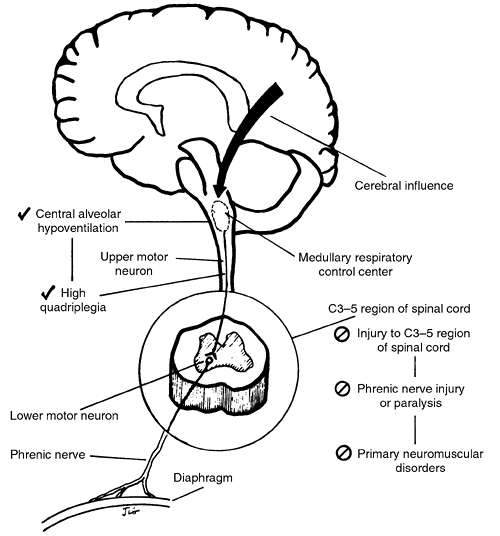 |
Fig. 50-3. Respiratory control system as regards disorders appropriate or inappropriate for diaphragm pacing. The involuntary medullary respiratory control center is subject to a degree of cerebral voluntary influence. The upper motor neurons of the phrenic system have their cell bodies in the medullary respiratory control center. The axons of the upper motor neurons synapse in the spinal cord with the lower motor neurons, at the level of C3 to C5. The phrenic nerve proper is composed of the axons of those lower motor neurons. Check marks indicate appropriate indications for diaphragm pacing. International verboten symbols identify inappropriate indications. |
High cervical quadriplegia (at the C2 to C3 levels or higher) eliminates spontaneous ventilation by disrupting the tracts that lead from the medullary respiratory control center to the spinal cord (Fig. 50-3). However, the integrity of the phrenic nerve is maintained because the cell bodies of the phrenic nerve are spared from injury.
High cervical spinal cord lesions also denervate the intercostal (T1 to T12), abdominal (T7 to L1), and pelvic (L1 to S2) accessory muscles of respiration. Only the sternocleidomastoid and trapezius muscles, which are innervated by the spinal accessory nerve (cranial nerve XI), remain functional. The neurologic findings that distinguish high quadriplegia are shown in Figure 50-4. In general, patients with high quadriplegia demonstrate intact sensation only to the clavicles; motor function is disrupted from the deltoid muscle and below.
The respiratory paralysis from high quadriplegia is directly correctable by diaphragm pacing. When a patient with high quadriplegia manifests respiratory paralysis and the phrenic nerve is found to be intact, diaphragm pacing is indicated if the patient's overall status permits.
PACING PREREQUISITES
Diaphragm pacing requires at least an intact phrenic nerve and a functional diaphragm. Phrenic nerve stimulation is not indicated for patients in whom the nerve is injured or dysfunctional. Examples include direct nerve injury from trauma, as a complication of cardiac surgery, as pointed out by Dimopoulou (1998) and Diehl (1994) and their associates, or through involvement from malignancy or infection. Figure 50-3 illustrates schematically the levels of neurologic insult that represent appropriate and inappropriate circumstances for diaphragm pacing.
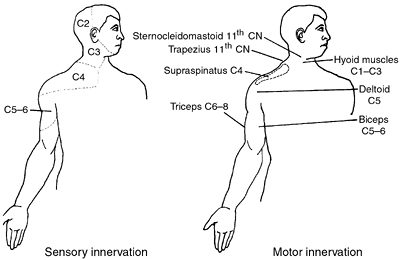 |
Fig. 50-4. Sensory and motor findings that allow discrimination of high quadriplegia. Quadriplegia at C2 to C3 or higher is well treated by diaphragm pacing. CN, cranial nerve. |
It is also critical that the diaphragm muscle be inherently sound in order to tolerate pacing. In general, a diaphragm affected by a primary muscular disorder such as myasthenia gravis or muscular dystrophy is not appropriate for pacing. Patients with central hypoventilation should demonstrate at least a 5-cm maximal excursion of the diaphragm with spontaneous breathing before embarking on diaphragm pacing; 8 to 10 cm is average. Quadriplegic patients are not required to exhibit the same degree of excursion with phrenic nerve stimulation as spontaneously ventilating patients. The diaphragm is expected to atrophy with disuse from quadriplegia and can be corrected with gradual conditioning. However, some brisk downward deflection of the diaphragm with percutaneous stimulation of the phrenic nerve should be observed, even in quadriplegia.
Diaphragm pacing requires that the ability of the lungs to oxygenate and ventilate be preserved. In most cases, pulmonary function test results should be normal or minimally compromised because pacing cannot compensate for severe restrictive or obstructive lung disease. For similar reasons, major deformities of the chest wall contraindicate diaphragm pacing by virtue of their mechanical interference with ventilatory function.
Equally imperative for successful diaphragm pacing is a knowledgeable and cooperative patient. Patients who have suffered permanent cognitive impairment are not appropriate candidates for pacing. Aside from important issues of health care allocation, a brain-damaged status prevents appreciation of many of the benefits of diaphragm pacing. Paramount to the success of an individual patient is a supportive network of family members and friends and a professional team of health care providers who are familiar with pacing techniques and the long-term aftercare.
Phrenic Nerve Function
Because an intact phrenic nerve is essential for pacing, accurate assessment of nerve function assumes paramount importance. Sarnoff (1951) and Shaw (1980) and their colleagues have described the technique for transcutaneous testing of phrenic nerve conduction (Fig. 50-5). The overall technique is similar to that for any nerve conduction test. A thimble electrode facilitates testing of the phrenic nerve. The motor point of the nerve is located medial to the lateral edge of the clavicular head of the sternocleidomastoid muscle. With the sternocleidomastoid
P.750
muscle retracted medially, stimulation is applied by the thimble electrode; the current is directed posteriorly. We look for brisk ipsilateral hemidiaphragmatic contraction, which is visible and grossly palpable on physical examination. Additionally, the muscle action potential of the diaphragm and the phrenic nerve conduction time may be measured with the use of surface electrodes. Two electrodes are placed at about the level of the eighth intercostal space, one in the anterior axillary line and the other in the posterior axillary line. A ground electrode is placed at the xiphoid. The phrenic nerve conduction time is measured as the elapsed time from phrenic nerve stimulation at the neck until a diaphragmatic action potential is recorded by an oscilloscope. The phrenic nerve conduction time for the adult is normally 7.5 to 10.0 ms. A prolonged conduction time (greater than 11 ms) is considered abnormal; however, slightly prolonged times (11 to 14 ms) do not necessarily preclude pacing.
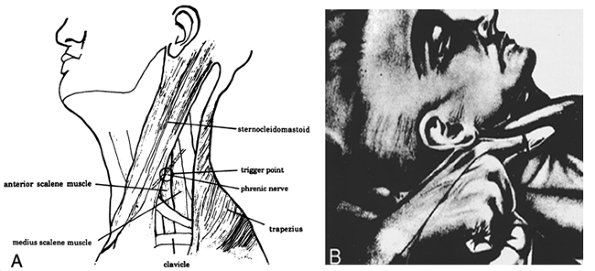 |
Fig. 50-5. Testing for viability of the phrenic nerve by percutaneous electrical stimulation. A. The trigger point at the border of the clavicular head of the sternocleidomastoid where the phrenic nerve is accessible to stimulation as it crosses on the scalene muscles. B. Application of the thimble electrode. |
Phrenic nerve conduction time also may be assessed using cervical magnetic stimulation. A magnetic coil placed on the neck causes depolarization of the intraforaminal segments of cervical nerve roots C3 to C5. Bilateral, simultaneous stimulation of the nerve roots is usually performed; however, Mills and co-workers (1995) have shown that unilateral stimulation is possible. Because depolarization is applied to the intraforaminal segments of the roots that make up the phrenic nerve rather than the nerve per se, cross-stimulation of additional muscles that may be partially or completely supplied by the same intraforaminal segments may occur. Careful interpretation of results with cervical magnetic stimulation is necessary because the results cannot be directly compared with those of percutaneous electromagnetic stimulation in which the phrenic nerve is directly and specifically stimulated. Although Similowski and associates (1996, 1997) have reported on the usefulness of cervical magnetic stimulation for the selection of phrenic pacing candidates when used in combination with cortical magnetic stimulation, the number of patients evaluated is small, and application of this device for phrenic nerve assessment is not standard.
The clinical response of the diaphragm to nerve stimulation is paramount. Intact conduction produces a dramatic and easily recognized contraction of the hemidiaphragm. Simple clinical inspection is often adequate; however, fluoroscopy can be used to quantify the amount of hemidiaphragm contraction. Failure to elicit a strong contraction almost invariably indicates a nonviable phrenic nerve. In rare instances, nerve viability cannot be ascertained by noninvasive methods. Under these circumstances, if pacing is deemed critical, operative exploration and direct stimulation of the nerve should ensue.
Patients with spinal cord injury may have delayed recovery of respiratory function such that an initially ventilator-dependent patient may recover spontaneous respiratory function. Therefore, an interim period of at least 3 months after injury is best undertaken before the final decision for diaphragm pacing is made. This waiting period allows many issues related to the acute injury to resolve. Patients find time to establish rehabilitation regimens, including those related to altered bowel and bladder function and the prevention of decubitus ulcers. The quadriparetic patient also may require a time period of psychological adjustment. In the event pacing is determined necessary, proper attention to these related issues is essential to its overall success.
P.751
It should be noted that preliminary forays into nerve grafting (using the intercostal or vagus nerves) to replace a damaged phrenic nerve are being made. Very initial experience appears promising, as reported by Krieger and Krieger (2000).
TECHNIQUES
Pulse Train Stimulation
Unlike cardiac muscle, which is able to propagate a single electrical impulse to allow contraction, the diaphragm is not an electrical syncytium. Thus, a single stimulus, such as that delivered by a cardiac pacemaker, is insufficient to effect contraction of the diaphragm. Rather, a series of multiple stimuli is required to produce a mechanically effective diaphragm contraction. A series of such repeated stimuli is termed a pulse train, and several electrical parameters are defined in pulse train stimulation (Fig. 50-6). The rate determines the overall number of pulse trains delivered by diaphragm pacing per minute; this corresponds to the respiratory rate. The pulse train duration determines the length of time of the pulse train, which, in turn, determines the duration of inspiration. The pulse width determines the length of time for any one individual impulse, and the number of impulses within a pulse train is called the frequency. Frequency also can be expressed by its inverse, the pulse interval, which determines the length of time between individual impulses within a pulse train. Specifically, frequency (Hz) = 1,000 ms/pulse interval. The amplitude determines the voltage of each stimulus within the pulse train. This determines the strength of the diaphragm contraction and the resulting tidal volume.
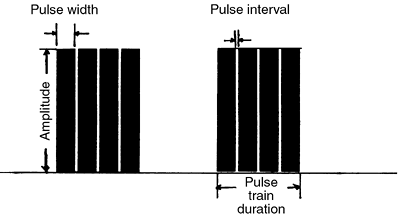 |
Fig. 50-6. Pulse train stimulation. Characteristics (and unit measurements) describing pulse train stimulation are: rate (breaths per minute, bpm), overall number of pulse trains delivered per minute; amplitude (v), voltage of each stimulus in a pulse train series; pulse width (ms), duration of an individual pulse; pulse interval (ms), duration between pulses in a train; frequency (Hz), timing of stimuli within a pulse train [frequency (Hz) = 1,000 per pulse interval]; pulse train duration (ms), overall duration of one train of pulses, corresponding to inspiratory duration. |
Electrode stimulation of the phrenic nerve may be performed in either monophasic or biphasic fashion. Biphasic stimulation, in which alternating positive and negative currents are used, requires less electrical energy and may reduce nerve injury. Likewise, stimulation may be done in unipolar or bipolar mode, depending on the number of electrodes in contact with the nerve.
It cannot be overemphasized that diaphragm pacing requires an intact and functional phrenic nerve. Although experimental studies of direct intramuscular stimulation of the phrenic nerve have been performed by Peterson and associates (l994a, 1994b), these techniques have found limited clinical application. Intramuscular stimulation of the diaphragm probably occurs through the branches of the phrenic nerve as the nerve divides in the central portion of the diaphragm. Unfortunately, atrophy of the denervated muscle in cases of phrenic nerve injury would probably diminish the strength of the diaphragmatic contraction even in the event direct diaphragm stimulation was realized. Although successful phrenic nerve repair has been reported by Merav and colleagues (1983), and grafting by Baldissera (1993) and Krieger (1994) and their associates, the long-term merit of such endeavors remains unproved in terms of primary nerve function and ability to pace.
Pacing Equipment
Unlike cardiac pacemakers, which are totally implantable, diaphragm pacemakers have an extracorporeal generator, about the size of a clock radio, in addition to the surgically implanted nerve electrode and receiver. Output from the generator is carried through an antenna, the coil of which is taped securely to the patient's skin over the receiver site. The antenna transmits a radiofrequency signal to the implanted receiver, which resembles a pocket watch in size and shape. Through inductive coupling, a stimulating signal is conducted to the receiver and across the electrode to stimulate the phrenic nerve (Fig. 50-7). Despite the external position of the generator and the inductive coupling arrangement for transmission of the signal to the body, the system is reliable and relatively simple to teach. A portable generator also exists for ambulatory patients, which is about the size of a compact disc player. Designed by Glenn and colleagues (1972), the system remains the prototype for the three commercial pacing systems currently in use.
Although the goal of a totally implanted pacemaker has been long since achieved in an animal model by Hogan and co-workers (1976, 1989), a commercially available implant for clinical use has not been realized. The relatively low volume of diaphragm pacemakers implanted annually and the need for a battery adequate to power pulse train stimulation have contributed to the slow progress. Lanm ller and associates (1997) have reported their progress with an implantable pacemaker. The anticipated battery life is 3 to 5 years, depending
P.752
on the electrode type. The development of a rate-responsive diaphragm pacemaker, a feature already available in cardiac pacemakers, remains to be accomplished.
 |
Fig. 50-7. The apparatus for diaphragm pacing. A. The hardware. The transmitter, external antenna, implantable receiver, and phrenic nerve electrode are shown. The transmitter remains outside the body, as does the antenna, which is taped securely to the skin over the implanted receiver. B. Equipment in place in patient. Note placement of phrenic nerve electrode at the level of the upper thorax. The implanted receiver is situated over a flat portion of the lower chest wall. |
Commercial Devices
Currently, three pacing systems are in clinical use; each varies slightly with respect to design. The Avery system (Avery Laboratories, Glen Cove, NY) uses the half-cuff or 180-degree unipolar electrode as originally developed at Yale (Fig. 50-8). The system is also used for skeletal muscle stimulation in other clinical applications. The electrode is placed preferentially in 180-degree contact to avoid the potential nerve entrapment and injury from scar tissue that may occur with a 360-degree or full-cuff contact. Letsou and associates (1992) found experimentally that pacing with either the half-cuff or full-cuff configurations was comparable. The Avery system is the only commercially manufactured device in the United States; however, technical difficulties with receiver function and longevity have prompted the group at Yale to reconsider its use.
Currently, the Jukka Astrostim model (Atrotech OY, Tampere, Finland) is used at Yale and elsewhere with favorable results. This model differs from the Avery device by virtue of a quadripolar electrode. Two strips of Teflon, each carrying two electrode contacts, are opposed to the nerve, one behind and one in front. Any of the four electrode contacts may serve as the cathode, with its opposite contact serving as the anode. Stimulation of the phrenic nerve occurs through only one of the electrode contacts at any given time, permitting incomplete stimulation of the nerve fascicles and associated muscle bundles. Such selective stimulation is thought to resemble more closely natural respiration, in which incomplete recruitment of nerve fascicles allows some muscle bundles to do the work of breathing while others recover. At regular intervals, an increased tidal volume is affected using an increased stimulation current. These sighs allow additional conditioning of the diaphragm in the event recruitment of muscle mass is needed for increased ventilation requirements. An adapter is available to connect the Avery electrode with the Astrostim receiver for patients who have undergone previous placement of the former.
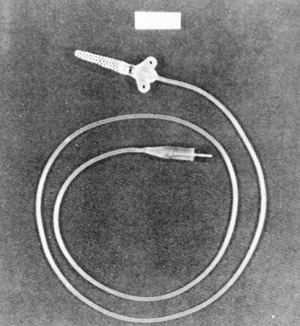 |
Fig. 50-8. Detailed view of the 180-degree half-cuff phrenic nerve electrode. |
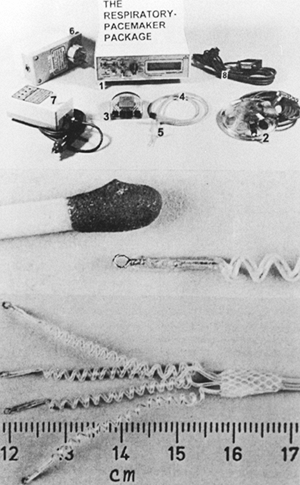 |
Fig. 50-9. Vienna phrenic pacemaker by Medimplant (Vienna, Austria). Top. The complete respiratory package including (1) battery-powered control, (2) radiofrequency transmission coil (external), (3) eight-channel implanted nerve stimulator, (4) electrode leads, (5) electrode contacts (see bottom frame), (6) power transformer for household current, (7) car battery power transformer, (8) trigger unit for respirator (used during training). Middle. Epineural electrode. Match head placed for size comparison. Bottom. Actual four-prong quadripolar electrode. From Creasey G, et al: Electrical stimulation to restore respiration. J Rehab Res Dev 33:123, 1996. With permission. |
P.753
Similar to the Astrostim model, the Vienna phrenic pacemaker, designed by Medimplant, Inc. (Vienna, Austria), stimulates the nerve using multiple electrode contacts with incomplete stimulation of the nerve. The electrode is also a quadripolar unit of carousel design (Fig. 50-9). Both phrenic nerves are activated through one receiver.
Device Implantation
In implanting the system, extreme caution is taken in placing the electrode to the phrenic nerve because damage to the nerve during implantation would essentially preclude pacing. The operation is done through a limited anterior thoracotomy in the second or third intercostal space (Fig. 50-10). The pectoral muscle is divided in the direction of its fibers. The internal mammary artery and vein are divided deliberately to avoid accidental disruption while transecting the intercostal muscles. On entering the thorax, the phrenic nerve is identified on the mediastinal surface, anterior to pulmonary hilum. A location is chosen superior to the heart where the phrenic nerve is accessible and where the electrode can be placed so as to lie perfectly flat beneath the nerve. The mediastinal pleura is incised parallel to the nerve, both anteriorly and posteriorly, and several millimeters away from the neurovascular bundle. The electrode is slipped atraumatically behind the mobilized phrenic structures, such that the phrenic bundle rests inside the half-cuff platinum contact of the electrode in the case of the unipolar electrode. The Silastic portions of the electrode are secured by suture to the mediastinal pleura. Perfect lie of the electrode must be obtained such that no distortion or traction on the nerve results; delayed injury or dysfunction of the nerve may result otherwise. Bleeding from the artery or vein accompanying
P.754
the nerve is not treated if minor. This usually stops spontaneously; application of cautery could well injure the delicate nerve. With careful attention to atraumatic technique, injury to the phrenic nerve should be avoidable.
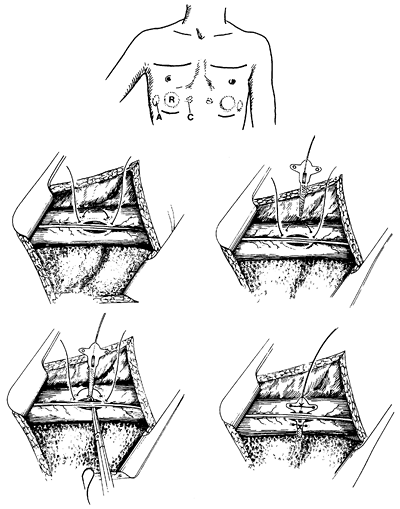 |
Fig. 50-10. Transthoracic approach to the phrenic nerves for diaphragm pacing. Top. Incisions in the second interspace for nerve access. Incisions at the costal margin for implantation of receiver (R), anode plate (A), and connectors (C). Middle, bottom. Sequential steps in implantation of 180-degree electrode behind the phrenic nerve. Modified from Glenn WWL: The diaphragm. In Glenn WWL (ed): Thoracic and Cardiovascular Surgery. 4th Ed. East Norwalk, CT: Appleton-Century-Crofts, 1983, p. 363. With permission. |
The other end of the electrode is passed carefully through the chest wall using a chest tube to avoid trauma during its passage. Redundant wire is left within the thorax, on the surface of the lung, to avoid tension on the electrode with lung excursion. The excess wire is placed into a Teflon bag to facilitate future access. A precise subcutaneous pocket is created over a flat portion of the lower anterolateral rib cage to house only the receiver, with precise closure of the pocket to prevent receiver migration. As with any device implantation, the incision is closed away from the underlying receiver to avoid any undue pressure, which can result in improper healing, dehiscence, or both.
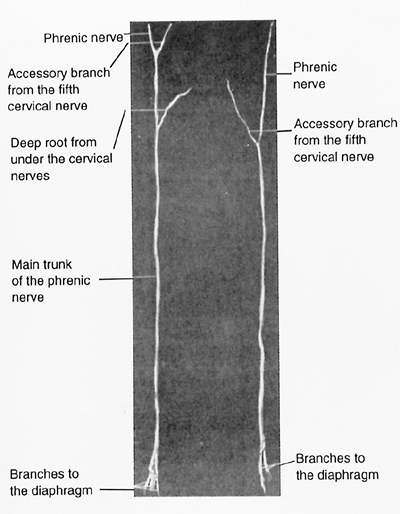 |
Fig. 50-11. Phrenic nerves removed by the operation of exeresis, a treatment in the early 20th century for apical tuberculosis. To effect diaphragm paralysis, surgeons removed the phrenic nerve and associated branches by avulsion in the neck. Nebenphrenicus, probably the branch of the fifth cervical, the so-called accessory branch, is presumed to join the nerve trunk at the cervical level on the right. On the left side, the branch joins the nerve trunk at a lower level and would probably not be stimulated by an electrode in the cervical location. From Glenn WWL, Sairenji H: Diaphragm pacing in the treatment of chronic ventilatory insufficiency. In Roussos C, Macklem PT (eds): The Thorax, Part B. New York: Marcel Dekker, 1985, p. 1434. With permission. |
Implantation of a cervical electrode is somewhat controversial. Advocates of this approach cite technical ease of electrode placement in the neck compared with that through the thoracic approach, especially in the patient with a mildly deformed thorax or with an element of pulmonary parenchymal disease. Bilateral concurrent implantation of the nerves may be performed. However, the cervical approach is discouraged for several reasons, the most important of which is the existence of accessory phrenic nerve radicals that originate below the C3 to C5 level that do not join the phrenic nerve until a mediastinal location (Fig. 50-11), as pointed out by Kelly (1950) as well as by Glenn and Sairenji (1985). A cervically placed electrode would not stimulate these radicals. Other anatomic variations also exist within the neck. The nerve may be adjacent to the brachial plexus, intramuscular in the scalenus anticus muscle, or bifurcated; under these circumstances, electrode placement may prove awkward.
In the event that cervical placement is chosen, patients should be temporarily intubated if a tracheostomy is not already present. When a tracheostomy is present, the site is covered with an occlusive dressing to decrease the risk for contamination during electrode placement. An incision of about 5 cm is made above and parallel to the midportion of the clavicle. The lateral border of the sternocleidomastoid muscle is identified and retracted medially with the internal jugular vein. At this level, the nerve is almost always found overlying the scalenus anticus muscle, just deep to the scalene fascia, as it crosses from the lateral to medial aspect of the muscle. A stimulation probe is positioned, and 2 to 10 mA of current applied. Diaphragm contraction confirms correct identification of the nerve. Nerve dissection and placement of the permanent nerve electrode and radiofrequency receiver proceed in a fashion similar to that used in the chest. The subcutaneous pocket is created in the infraclavicular region by blunt dissection through the existing cervical incision.
Placement of the Medimplant device is usually performed through a median sternotomy because both electrodes are stimulated from a single receiver. The prongs of the electrode are carefully sutured using microsurgical technique to the epineural tissue using fine (8-0) polypropylene suture.
The system is tested in the operating room to confirm function before the patient is undraped. Testing is performed with a sterile antenna passed off the operating field to the extracorporeal generator. Excellent contraction of the diaphragm with pacing should occur in a threshold range of 1.0 to 2.0 mA. Pacing that requires high-threshold values, or failure to pace at all, requires reevaluation of the lead for improper placement or displacement, injury to the lead, or injury to the phrenic nerve itself. Infection is avoided through the use of meticulous technique and prophylactic antibiotics. Implantation of the right and left pacemaker systems is usually performed about 2 weeks apart.
Recently, thoracoscopic and laparoscopic placement of the stimulating electrode have been reported by Shaul (2002),
P.755
Schmit (1998), and DiMarco (2002) and their colleagues. It should be emphasized that laparoscopic placement of the electrode on the abdominal side of the diaphragm is as yet nearly completely untested for efficacy, safety, and durability in large numbers of patients.
Device Settings
Fluoroscopy performed at the initial evaluation of the diaphragm and at pacemaker implantation is used to determine threshold current settings. A fluoroscopically visible ruler is placed beneath the diaphragm with numeral 1 visible at the dome of the diaphragm. The anteroposterior distance of the x-ray tube is kept constant at 30 cm for all diaphragm evaluations. Maximal voluntary descent is determined for patients with central hypoventilation. The threshold current, the amount needed to produce a contraction of the diaphragm that is just discernible, is measured. The amount of current needed for maximal contraction of the diaphragm and the degree of descent associated with this current are measured. For clinical pacing, the current is set just above that needed for maximal excursion. Reassessment of the diaphragm with respect to current settings is performed at intervals thereafter.
The respiratory rate is individualized for each patient. In adult patients undergoing bilateral pacing, 6 to 10 breaths per minute usually suffice. Adults who are paced unilaterally and children require a faster rate. Pacemaker default settings for inspiratory duration and pulse width are usually preset by the manufacturer. For adults, the inspiratory duration is usually 1.3 seconds, and pulse width is 150 ms. Inspiration duration for children is adjusted to 0.9 seconds. Frequency and pulse interval settings are discussed subsequently in the context of diaphragm conditioning.
Conduct of Pacing
Pacing is not begun until 2 weeks after device implantation is complete because earlier initiation led to the development of bloody pleural effusions. This may represent disruption of immature adhesions by strong diaphragm contraction elicited by pacing.
Several modes of pacing are possible: unilateral, pacing on alternating sides (usually at 12-hour intervals), or simultaneous bilaterally pacing. Unilateral pacing may suffice in selected circumstances, such as in patients with central alveolar hypoventilation; however, the preference of the Yale group is to condition the diaphragm for low-frequency, continuous bilateral stimulation.
No skeletal muscle, including the diaphragm, is able to perform maximal continuous work. Although the diaphragm contracts incessantly to provide respiration, activation of the individual nerve fascicles and muscle bundles is staggered such that during any given breath, a percentage of dormant motor units is allowed metabolic recovery from previous activation. Because pulse train stimulation of the phrenic nerve activates most, if not all, of the nerve's fascicles and muscle bundles, individual motor units are not allowed to rest, and the unconditioned diaphragm tires easily.
Because of these issues, a program of gradual conditioning is used to allow the diaphragm to acclimate to pulse train electrical stimulation and, in the case of quadriplegia, restore the diaphragm, which has atrophied from disuse. The pacing schedule usually begins with 15 minutes of pacing per hour, in the supine position, for several hours a day. The number of minutes per hour and the number of hours per day are gradually increased in a systematic fashion until full-time pacing is achieved. Increases in the pacing regimen are made approximately every 7 to 14 days as tolerated by the patient. The adaptive process may require weeks to months, depending on the condition of the diaphragm at the inception of pacing. Quadriplegic patients require longer conditioning times than patients with central hypoventilation. Along with progressive increases in the pacing period, the frequency of stimuli in the pulse train is decreased progressively, usually to approximately 7.1 Hz, corresponding to a pulse interval of 140 ms, to minimize diaphragm fatigue and allow longer pacing periods. Also to minimize fatigue, the number of breaths per minute is progressively decreased to the lowest number that provides adequate ventilation. When the patient is sitting, the ventilatory rate is increased by one breath per minute to maintain adequate ventilation. A snug abdominal binder is placed in sitting quadriplegic patients.
Tidal volume, minute volume, end-tidal partial pressure of carbon dioxide, and oxygen saturation are monitored at the beginning and end of each pacing period as well as at regular intervals during pacing. Measurements are usually done hourly until the patient is well advanced on the pacing protocol. Noninvasive monitoring, using oxygen saturation and end-tidal carbon dioxide monitors, is correlated periodically with arterial blood gases.
A decrease in the tidal volume or increase in end-tidal partial pressure of carbon dioxide, in the absence of specific correctable pulmonary problems, is considered to be evidence of diaphragm fatigue. The patient is rested temporarily on mechanical ventilation, and pacing is resumed with a shorter pacing period.
The fully conditioned diaphragm demonstrates histologic and biochemical changes that underlie its ability to perform sustained work. Normally, the diaphragm is composed of three types of muscle fibers. Most type I fibers (55%) are oxidative, slow-twitch fibers that easily resist fatigue. Type IIB fibers (24%) are glycolytic, fast-twitch fibers that are prone to fatigue. Type IIA (21%) fibers have intermediate characteristics: fast twitch, fatigue resistant, and oxidative. This ratio of different fiber types allows the normally functioning diaphragm considerable flexibility in meeting various metabolic demands. With prolonged periods of pulse
P.756
train stimulation, this mixture of glycolytic and oxidative fibers is transformed into a state exclusively composed of slow-twitch, oxidative fibers, allowing for continuous sustained mechanical work.
Patients with central hypoventilation who require only part-time, nocturnal pacing of 8 to 12 hours can implement their full pacing plan immediately; the period of time that the patient is not paced is adequate to prevent diaphragm fatigue. These patients usually undergo high-frequency pacing with 20 to 25 Hz, with corresponding pulse interval of 40 to 50 ms.
Tracheostomy
After full-time ventilation is achieved, a Teflon tracheal button can be substituted in place of the conventional tracheostomy tube (Fig. 50-12). This tracheal device maintains the airway similarly to a tracheostomy; however, the button is more cosmetically appealing by virtue of being barely visible when in place. In addition, patients have more normal speech and reduced tracheal irritation and injury. The inner plug of the button is removed during sleep to ensure an unobstructed airway.
Ideally, even patients who have achieved full-time, continuous pacing should retain a permanent tracheostomy. It is known that pacing can produce extremely vigorous diaphragm contractions that, when combined with a lack of muscle coordination in the upper airway, can cause upper airway obstruction. All patients are instructed to leave the stoma open during sleep. In addition, a maintained tracheostomy provides secure airway access in the event malfunction of the pacemaker system occurs, necessitating immediate positive-pressure ventilation.
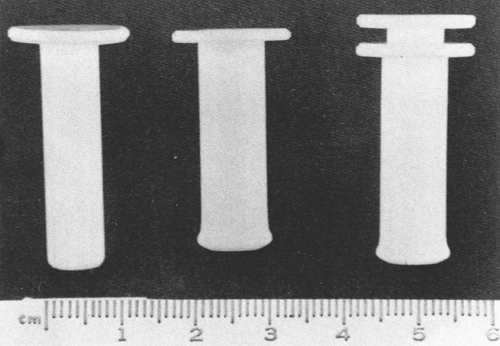 |
Fig. 50-12. The tracheal button used to replace the tracheostomy tube in conditioned, full-time pacing patients. The inner plug is shown on the left, the open tube in the middle, and the two assembled components on the right. The flange of the button sits flush with the skin when the button is in place in the stoma, maintaining patency indefinitely, while maintaining cosmesis. From Glenn WWL, et al: Long-term ventilatory support by diaphragm pacing in quadriplegia. Ann Surg 183:566, 1976. With permission. |
Complications
Unlike cardiac pacemakers, which require minimal associated care, diaphragm pacemakers mandate a thorough understanding of the device and its limitations and the principles of pacing techniques to produce successful pacing. Potential complications of the pacemaker include receiver and electrode failure. Weese-Mayer and colleagues (1996) conducted a study of component failure in 33 patients. The most common complication was receiver failure, occurring, on average, at 56.3 months. Failure may occur as the epoxy capsule of the receiver breaks down over time; ingress of fluid results, causing an electrical short of the internal components of the receiver. In patients with cardiac pacemakers, one must also be cognizant
P.757
of the potential complication of cross-talk between the two devices.
Other complications include acute and chronic phrenic nerve injury, diaphragm fatigue, and infection. Temporary and chronic stresses that especially occur in quadriplegic patients include bladder and pulmonary infections, pressure ulcers, and orthopedic deformities, especially scoliosis. These situations often increase the pacing requirements of the patient. Unfortunately, the pacing system does not automatically adjust to increased ventilatory demand. Careful assessment of the patient's condition and readjustment of the pacemaker is required to avoid the disastrous situation in which a pacing patient is returned to and maintained unnecessarily on mechanical ventilation.
RESULTS
The review of Glenn and colleagues (1988) of the worldwide experience with 477 patients who had undergone diaphragmatic pacemaker insertion demonstrated the feasibility of diaphragm pacing. Of the 165 patients in this series with detailed follow-up, pacing was completely successful in meeting the ventilation needs in 47%, partially successful in 35%, and unsuccessful in 17%. Twenty-seven percent of patients in this series paced full time and 61% of patients paced part time. Although no recent study of similar magnitude has been done, several smaller studies have examined long-term outcome.
Long-term follow-up for quadriplegic patients who were conditioned at Yale, when last reported by the senior author and associates (1992), revealed that of 14 patients, 7 continued to pace full time. At present, 6 of the original patients continue to pace full time; all have done so for more than 10 years. Two patients have died. Six patients who failed pacing, or pace only sporadically, do so for various reasons, including insufficient nursing and supportive care, progressive disability from quadriplegia, insufficient funds to continue pacing, and patient noncompliance.
Similarly, Fodstad's series (1995) of 42 patients who underwent diaphragm pacemaker placement over a 13-year period revealed that 19 patients continued to pace full time at a mean follow-up of 62 months. Seven patients died after pacing for periods that ranged from 4 months to 11 years. Five patients pace intermittently, and 8 patients have stopped pacing for reasons including phrenic nerve root (C3 to C5) injury in 6 patients and voluntary cessation in 2 patients. Three patients died before pacing was achieved.
Weese-Mayer and associates (1996) reviewed the results of 64 patients, including 35 children, who underwent quadripolar electrode pacing. At a mean follow-up of 2 years for children, pacing was successful in 94%. Successful pacing without complications, however, was substantially lower in adults (60%). At a mean follow-up of 2.2 years for the adults, the success rate and complication-free success rate were 86% and 52%, respectively. Electrode dysfunction was the most common complication overall (19%); infection occurred in 2.9%, and phrenic nerve damage developed in 3.8%.
Results of the Medimplant device were reviewed in children and adults. Mayr and associates (1993) reported on 15 patients with high cervical injury (C3 and above) who underwent pacemaker placement. Eleven patients achieved conditioned diaphragm pacing and paced for a mean of 43.3 months. Four patients died after pacing for 60, 58, 31, and 7 months. Causes of death were pulmonary embolism, pneumonia, and sepsis in 3 patients. The reason for one death was unclear. Girsch and colleagues (1996) reported 8 children, whose ages ranged from 2 to 13 years, who underwent placement of the Vienna pacemaker. One child was diagnosed with central alveolar hypoventilation; the other 7 children suffered high cervical or brainstem damage from tumor or trauma. Full-time pacing was achieved in 4 patients, with a mean conditioning time of 13 months. These children have paced for 10, 28, 38, and 48 months. One child continued to undergo conditioning. Pacing was intermittent in 2 children. One child refused to pace secondary to social difficulties despite the physical ability to do so.
Hunt (1978) and Brouillette (1988) and their associates have clarified certain characteristics specific to pacing of infants and young children. Their experience in 32 patients with predominantly congenital central hypoventilation demonstrated that pacing can be effective; 25 of the 32 patients survived, and most were rehabilitated adequately to allow return to home. Both Hunt (1978) and Brouillette (1988) and their colleagues have established that pacing of one diaphragm is poorly tolerated because of excess mediastinal motion; that shorter inspiration duration (0.9 seconds) is more efficient; and that full-time bilateral pacing of the infant or young child is not well tolerated. Motoyama (1977) attributed this intolerance of children to continuous pacing to the immaturity of the pediatric musculoskeletal system. By the age of 8 to 10 years, these issues have largely resolved, and pacing tolerance and technique more closely approximate those for the adult.
At present, no prospective trial has been performed to compare diaphragm pacing with mechanical ventilation or other models of ventilatory support, nor is one foreseen. The number of patients who require or qualify for pacing is limited, and the population of patients is heterogeneous. Whether diaphragm pacing imparts improved survival in patients with either quadriplegia or central hypoventilation remains unclear. However, it has been the experience of the group at Yale that, at least in patients with central alveolar hypoventilation, progressive respiratory deterioration is common, and death from hypoventilation is possible in the untreated individual. Moreover, the sequelae of prolonged hypoventilation and hypoxia include cor pulmonale from chronic hypoxic vasoconstriction and permanent cerebral dysfunction. In this regard, diaphragm pacing is thought to
P.758
retard the decline in overall function that would otherwise result in untreated hypoxia.
Similarly, although no comparative trials have established the superiority of pacing over mechanical ventilation in patients with quadriplegia, some inferences may be drawn from accumulated clinical data. Carter and associates (1987a, 1987b) at the Texas Institute for Rehabilitation and Research compared their experience over 17 years in treating ventilator-dependent patients with spinal cord injury with mechanical ventilation (19 patients) versus diaphragm pacing (18 patients). The survival rates of diaphragm-paced patients and ventilated patients were 39% and 32%, respectively. Although pacing survival was slightly greater, no statistically significant difference was seen. However, because the specific mode of pacing was not mentioned and the study is somewhat dated, it is proposed that a more favorable result in the paced population of patients might be seen if all had been paced with continuous, bilateral, low-frequency stimulation.
One of the authors (JAE) and colleagues (2002) recently reported the very long-term experience with diaphragm pacing in a relatively large cohort of patients with high quadriplegia. This experience indicated some very positive results. Respiratory mechanics (as judged by tidal volume and arterial blood gases) were entirely maintained over the very long term (Fig. 50-13). Also, there was no evidence whatsoever of damage to the phrenic nerve from long-term electrical stimulation. In fact, threshold current and current for maximal stimulation remained remarkably constant despite very long-term electrical stimulation. This chronic investigation confirmed that quadriplegic patients are indeed able to meet long-term, full-time ventilation requirements using phrenic nerve stimulation of the conditioned diaphragm.
 |
Fig. 50-13. Respiratory mechanics as judged by tidal volume and arterial blood gases were entirely maintained over the very long term, as shown here across the span of 120 months. |
ADVANTAGES AND CAVEATS OF DIAPHRAGM PACING
Diaphragm pacing offers a number or advantages over positive-pressure ventilation. Patients who successfully complete a pacing program readily attest to the increased ease with which they are able to travel, whether for work, study, or pleasure. In this regard, the development of a totally implanted pacemaker for clinical use would represent an even greater advance; its arrival is eagerly anticipated.
In addition to increased freedom, paced patients have more natural phonation and speech. The advent of the tracheal button decreases their risk for tracheal complications
P.759
associated with prolonged ventilation, such as tracheal stenosis, erosion, and tracheoesophageal fistula. Pacing patients are not exposed to the potential complications of mechanical ventilation such as accidental disconnection from the ventilator and tracheostomy occlusion from excessive airway secretions.
Patients who undergo diaphragm pacing also may find reduced health care costs because many are able to reside at home or outside of an institutionalized setting. After the initial cost of the pacing equipment and conditioning period, a maintained pacing system is relatively inexpensive.
Nonetheless, it must be emphasized that successful pacing requires critical patient selection, including a thorough assessment of the patient's phrenic nerve and diaphragm function, underlying pulmonary function, and cognitive ability. The social environment in which the patient is expected to pace is equally important. Patients who fail to meet the prerequisites for pacing or have questionable indications for pacing often do not pace successfully, despite a considerable emotional, physical, and financial investment. Conversely, patients with the proper indications and adequate medical, psychological, and social support enjoy the benefits of successful pacing, which are readily apparent in terms of quality of life, medical condition, and financial savings.
REFERENCES
Baldissera F, et al: Diaphragm reinnervation by laryngeal motoneurons. J Appl Physiol 75:639, 1993.
Beard GM, Rockwell AD: Practical Treatise on the Medical and Surgical Uses of Electricity. 2nd Ed. London: Lewis, 1875, pp. 214 318.
Brouillette RT, et al: Stimulus parameters for phrenic nerve pacing in infants and children. Pediatr Pulmonol 4:33, 1988.
Burney RE, et al: Incidence, characteristics, and outcome of spinal cord injury at trauma centers in North America. Arch Surg 236:596, 1993.
Carter RE: Comparative study of electrophrenic nerve stimulation and mechanical ventilatory support in traumatic spinal cord injury. Paraplegia 25:86, 1987a.
Carter RE: Respiratory aspects of spinal cord injury management, Paraplegia 25:262, 1987b.
Creasey G, et al: Electrical stimulation to restore respiration. J Rehab Res Dev 33:123, 1996.
de La Motte Fouque FHK: Undine. A Miniature Romance. Translated by Rev. Thomas Tracy. Standard Library, London: W. Smith, 1839, pp. 1 32.
Diehl JL, Lofaso F, Deleuze P: Clinically relevant diaphragmatic dysfunction after cardiac operations. J Thorac Cardiovasc Surg 107:487, 1994.
DiMarco AF, Budzinska K, Supinski GS: Artificial ventilation by means of electrical activation of the intercostal accessory muscles alone in anesthetized dogs. Am Rev Respir Dis 139:961, 1989.
DiMarco AF, et al: Activation of the inspiratory intercostal muscles by electrical stimulation of the spinal cord. Am Rev Respir Dis 136:1385, 1987.
DiMarco AF, et al: Evaluation of intercostal pacing in provide artificial ventilation in quadriplegics. Am J Respir Crit Care Med 150:934, 1994.
DiMarco AF, et al: Phrenic nerve pacing in a tetraplegic patient via intramuscular diaphragm electrodes. Am J Respir Crit Care Med 166:1604, 2002.
Dimopoulou I, et al: Phrenic nerve dysfunction after cardiac operations: electrophysiologic evaluation of risk factors. Chest 113:8, 1998.
Duchenne GDA. De l'ectrisation localis e et de son application a la pathologie et a le therapeutique par courant induits et par courants galvaniques interrompus par le Dr. Duchenne. Paris: Baliere, 1872.
Elefteriades JA, et al: Long-term follow-up of bilateral pacing of the diaphragm in quadriplegia. N Engl J Med 326:1433,1992.
Elefteriades JA, et al: Long-term follow-up of pacing of the conditioned diaphragm in quadriplegia. Pacing Clin Electrophysiol 25:897, 2002.
Erdmann BA: Dieortliche Anwendung der Elektricitat in der Physiologie. Pathologic und Therapie. 2nd Ed. Leipzig, Germany: Berlag von Joh. Ambr. Barth.,1858, p. 240.
Fodstad H: Phrenicodiaphragmatic pacing. In Roussos C (ed): The Thorax. 2nd Ed. Paris: Marcel Dekker, 1995, p. 2597.
Giraudoux JH. Ondine. Ids et Calendes. Paris: Neuchatel & Paris, 1946, pp. l6 267.
Girsch W, et al: Vienna phrenic pacemaker experience with diaphragm pacing in children. Eur J Pediatr Surg 6:140, 1996.
Glenn WWL: The treatment of respiratory paralysis by diaphragm pacing. Ann Thorac Surg 30:106, 1980.
Glenn WWL: The diaphragm. In Glenn WWL (ed): Thoracic and Cardiovascular Surgery. 4th Ed. East Norwalk, CT: Appleton-Century-Croft, 1983, p. 363.
Glenn WWL, Elefteriades JA: The diaphragm: dysfunction and induced pacing. In Baue AE, et al (eds): Glenn's Thoracic and Cardiovascular Surgery. 5th Ed. Norwalk. CT: Appleton-Century-Croft, 1991.
Glenn WWL, Gee BL, Schachter EN: Diaphragm pacing: application to a patient with chronic obstructive pulmonary disease. J Thorac Cardiovasc Surg 75:273. 1978.
Glenn WWL, Sairenji H: Diaphragm pacing in the treatment of chronic ventilatory insufficiency. In Roussos C, Macklem PT (eds):The Thorax. New York: Marcel Dekker, 1985, p. 1407.
Glenn WWL, et al: Electrical stimulation of excitable tissue by radio-frequency transmission. Ann Surg 160:338, 1964.
Glenn WWL, et al: Total ventilatory support in a quadriplegic patient with radiofrequency electrophrenic respiration. N Engl J Med 286:513, 1972.
Glenn WWL, et al: Long-term ventilatory support by diaphragm pacing in quadriplegia. Ann Surg 183:566, 1976.
Glenn WWL, et al: Ventilatory support for pacing of the conditioned diaphragm in quadriplegia. N Engl J Med 310:1150, 1984.
Glenn WW, et al: Twenty years of experience in phrenic nerve stimulation to pace the diaphragm. Pacing Clin Electrophysiol 9:780.1986.
Glenn WWL, et al: Fundamental considerations in pacing of the diaphragm for chronic ventilatory insufficiency: a multi-center study. Pacing Clin Electrophysiol 11:2121, 1988.
Hogan JF, Holcomb WG, Glenn WWL: A programmable totally implantable, battery-powered diaphragm pacemaker: design characteristics. In Saha S (ed): Proceedings of the Fourth New England Bioengineering Conference. Elmsford, NY: Pergamon, 1976, p. 221.
Hogan JF, Koda H, Glenn WWL: Electrical techniques for stimulation of the phrenic nerve to pace the diaphragm: inductive coupling and battery powered total implant in asynchronous and demand modes. Pacing Clin Electrophysiol 12:847, 1989.
Hufeland CW: Usum uis electriciac in asphyxia experimentis illustratum. G ttingen, Germany: Dissertatio Inauguralis Medica, 1783.
Hunt CE, Silvestri JM: Pediatric hypoventilation syndromes. Curr Opin Pulm Med 3:445, 1997.
Hunt CE, et al: Central hypoventilation syndrome: experience with bilateral phrenic nerve pacing in 3 neonates. Am Rev Respir Dis 118: 23,1978.
Israel P: Uber die Wiederbelebung scheintoter Neugeborener mit Hilfe des elektrischen Stroms. Z Geburtshilfe Gynakol 91:602, 1927.
Judson JP, Glenn WWL: Radio-frequency electrophrenic respiration. Long-term application to a patient with primary hypoventilation JAMA 203:1033, l968.
Kelly WD: Phrenic nerve paralysis: special consideration of the accessory nerve. J Thorac Surg 19:923, 1950.
Krieger AJ, Gropper MR, Adler RJ: Electrophrenic respiration after intercostal to phrenic nerve anastomosis in a patient with anterior spinal artery syndrome: technical case report. Neurosurgery 35:760. 1994.
Krieger LM, Krieger AJ: The intercostal to phrenic nerve transfer: an effective means of reanimating the diaphragm in patients with high cervical spine injury. Plast Reconstr Surg 105:1255, 2000.
Lanm ller H, et al: Useful applications and limits of battery powered implants in functional electrical stimulations. Artif Organs 21:210, 1997.
Letsou GV, et al: Comparison of 180-degree and 360-degree skeletal muscle nerve cuff electrodes. Ann Thorac Surg 54:925, 1992.
Mayr W, et al: Multichannel stimulation of phrenic nerves by epineural electrodes. Clinical experience and future developments. ASAIO J 39:M729, 1993.
Merav AD, Attai LA, Condit DD: Successful repair of the transected phrenic nerve with restoration of diaphragmatic function. Chest 84:642, 1983.
P.760
Mills GH, et al: Unilateral magnetic stimulation of the phrenic nerve. Thorax 50:1162, 1995.
Motoyama FK: Pulmonary mechanics during early postnatal years. Pediatr Res 11:220, 1977.
Noguchi T: A survey of spinal cord injuries resulting from sport. Paraplegia 32:170, 1994.
Peterson DK, et al: Long-term intramuscular electrical activation of the phrenic nerve: safety and reliability. IEEE Trans Biomed Eng 41:1115. 1994a.
Peterson DK, et al: Long-term intramuscular electrical activation of the phrenic nerve: efficacy as a ventilatory prosthesis. IEEE Trans Biomed Eng 41:1127. 1994b.
Sarnoff SJ, et al: Electrophrenic respiration in acute bulbar poliomyelitis. AMA 143:1383, 1950.
Sarnoff SJ, et al: Electrophrenic respiration. VII. The motor point of the phrenic nerve in relation to external stimulation. Surg Gynecol Obstet 93:90, 1951.
Schmit BD, et al: Laparoscopic placement of electrodes for diaphragm pacing using stimulation to locate the phrenic nerve motor points. IEEE Trans Rehabil Eng 6:382, 1998.
Shaul DB, et al: Thoracoscopic placement of phrenic nerve electrodes for diaphragmatic pacing in children. J Pediatr Surg 37:974, 2002.
Shaw RK, et al: Electrophysiological evaluation of phrenic nerve function in candidates for diaphragm pacing. J Neurosurg 53:345. 1980.
Shneerson J. Disorders of Ventilation. Oxford, England: Blackwell Scientific, 1988.
Similowski T, et al: Assessment of the motor pathway to the diaphragm using cortical and cervical magnetic stimulation in the decision-making process of phrenic pacing. Chest 110:1551, 1996.
Similowski T, et al: Comparison of magnetic and electrical phrenic nerve stimulation in assessment of phrenic nerve conduction time. J Appl Physiol 82:1190, 1997.
Spivak JM, et al: Cervical spine injuries in patients 65 and older. Spine 19:2302, 1994.
Sritippayawan S, et al: Mother-daughter transmission of congenital central hypoventilation syndrome. Am J Respir Crit Care Med 166:367, 2002.
Supinski GS: Effect of synchronizing intercostal muscle and diaphragm contraction on inspired volume production [Abstract]. Am Rev Respir Dis 143:A566, 1991.
Ure A: An account of some experiments made on the body of a criminal immediately after execution, with physiological and practical observations. J Sci Arts (Lond) 6:283, 1819.
Weese-Mayer DE, et al: Diaphragm pacing with a quadripolar phrenic nerve electrode: an international study. Pacing Clin Electrophysiol 19: 1311, 1996.
Reading References
Agoston E, et al: Static feature of the passive rib cage and abdomen-diaphragm. J Appl Physiol 20:1187, 1965.
Alander DH, Andreychik DA, Stauffer ES: Early outcome in cervical spinal cord injured patients older than 50 years of age. Spine 19:2299, 1994.
Chervin RD, Guilleminault C: Diaphragm pacing: review and reassessment. Sleep 17:176, 1994.
Elefteriades JA: Discussion of Miller JO, et al: Phrenic nerve pacing in quadriplegia. J Thorac Cardiovasc Surg 99:35.1990.
Lan C, el al: Traumatic spinal cord injuries in rural region of Taiwan: an epidemiological study in Hualien county 1986 90. Paraplegia 31:398. 1993.
MacLean IC, Mattioni TA: Phrenic nerve conduction studies: a new technique and its application in quadriplegic patients. Arch Phys Med Rehabil 62:70, 1981.
Markland ON, et al: Electrophysiologic evaluation of diaphragm by transcutaneous phrenic nerve stimulation. Neurology 34:604, 1984.
McCreery DB, Agnew WF: Mechanisms of stimulation-induced neural damage and their relation to guidelines for safe stimulation. In Agnew WF, McCreery DB (eds): Neural Prostheses: Fundamental Studies. Englewood Cliffs. NJ: Prentice-Hall, 1990.
McGory BJ, et al: Acute fractures and dislocations of the cervical spine in children and adolescents. J Bone Joint Surg Am 75:988, 1993.
Mellins RB, et al: Failure of automatic control of ventilation (Ondine's curse.): report on an infant born with this syndrome and review of the literature. Medicine (Baltimore) 49:487. 1970.
Mills KR, et al: The optimal current direction for excitation of human cervical motor roots with a double coil magnetic stimulator. Electroencephalogr Clin Neurophysin 89:l38, 1933.
Oda T, et al: Evaluation of electrical parameters for diaphragm pacing: an experimental study. J Surg Res 30:142, 1981.
Price C, et al: Epidemiology of traumatic spinal cord injury and acute hospitalization and rehabilitation charges for spinal cord injuries in Oklahoma, 1988 90. Am J Epidemiol 39:37, 1994.
Serif NS: Central alveolar hypoventilation syndrome. Trans Am Neurol Assoc 89:252, 1964.
Severinghaus JW, Mitchel RA: Ondine's curse. Failure of respiratory center automaticity while awake. Clin Res 10:122, 1962.
Shingu H, et al: Spinal cord injuries in Japan: a nationwide epidemiological survey in 1990. Paraplegia 32:3,1994.
EAN: 2147483647
Pages: 203